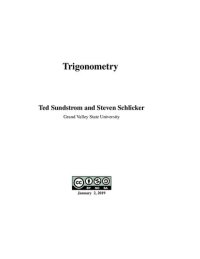
Ebook: Trigonometry
Author: Ted Sundstrom Steven Schlicker
- Genre: Mathematics
- Tags: Trigonometry, Trigonometric Functions, Triangles and Vectors, Trigonometric Identities and Equations, Complex Numbers and Polar Coordinates
- Year: 2019
- Publisher: Grand Valley State University
- City: Allendale
- Edition: 1
- Language: English
- pdf
This college level trigonometry text may be different than most other trigonometry textbooks. In this book, the reader is expected to do more than read the book but is expected to study the material in the book by working out examples rather than just reading about them. So the book is not just about mathematical content (although it does contain important topics in trigonometry needed for further study in mathematics), but it is also about the process of learning and doing mathematics and is designed not to be just casually read but rather to be engaged. Recognizing that actively studying a mathematics book is often not easy, several features of the textbook have been designed to help students become more engaged as they study the material. Some of the features are: Beginning activities in each section that engage students with the material to be introduced, focus questions that help students stay focused on what is important in the section, progress checks that are short exercises or activities that replace the standard examples in most textbooks, a section summary, and appendices with answers for the progress checks and selected exercises.
This text was written for the three-credit trigonometry course at Grand Valley State University (MTH 123 – Trigonometry). This text begins with a circular function approach to trigonometry and transitions to the study of triangle trigonometry, vectors, trigonometric identities, and complex numbers.
Important Features of the Textbook
This book is meant to be used and studied by students and the important features of the textbook were designed with that in mind. Please see the Note to Students on page (v) for a description of these features.
Content and Organization
The first two chapters of the textbook emphasize the development of the cosine and sine functions and how they can be used to model periodic phenomena. The other four trigonometric functions are studied in Section 1.6 and Section 2.4. Triangles and vectors are studied in Chapter 3, trigonometric identities and equations are studied in Chapter 4, and finally, using trigonometry to better understand complex numbers is in Chapter 5. Following is a more detailed description of the sections within each chapter.
This text was written for the three-credit trigonometry course at Grand Valley State University (MTH 123 – Trigonometry). This text begins with a circular function approach to trigonometry and transitions to the study of triangle trigonometry, vectors, trigonometric identities, and complex numbers.
Important Features of the Textbook
This book is meant to be used and studied by students and the important features of the textbook were designed with that in mind. Please see the Note to Students on page (v) for a description of these features.
Content and Organization
The first two chapters of the textbook emphasize the development of the cosine and sine functions and how they can be used to model periodic phenomena. The other four trigonometric functions are studied in Section 1.6 and Section 2.4. Triangles and vectors are studied in Chapter 3, trigonometric identities and equations are studied in Chapter 4, and finally, using trigonometry to better understand complex numbers is in Chapter 5. Following is a more detailed description of the sections within each chapter.
Download the book Trigonometry for free or read online
Continue reading on any device:

Last viewed books
Related books
{related-news}
Comments (0)